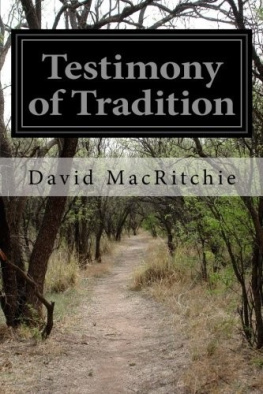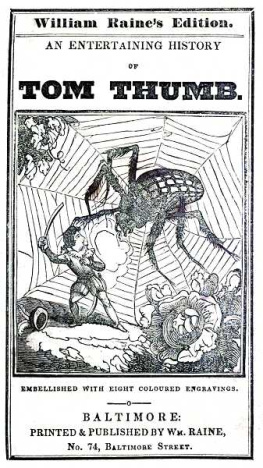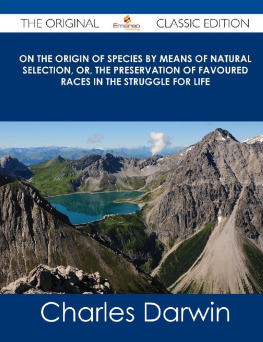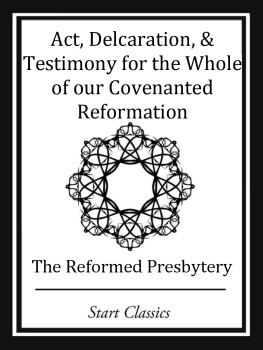David Macritchie - The Testimony of Tradition
Here you can read online David Macritchie - The Testimony of Tradition full text of the book (entire story) in english for free. Download pdf and epub, get meaning, cover and reviews about this ebook. year: 2013, publisher: Emereo Classics, genre: Science. Description of the work, (preface) as well as reviews are available. Best literature library LitArk.com created for fans of good reading and offers a wide selection of genres:
Romance novel
Science fiction
Adventure
Detective
Science
History
Home and family
Prose
Art
Politics
Computer
Non-fiction
Religion
Business
Children
Humor
Choose a favorite category and find really read worthwhile books. Enjoy immersion in the world of imagination, feel the emotions of the characters or learn something new for yourself, make an fascinating discovery.
- Book:The Testimony of Tradition
- Author:
- Publisher:Emereo Classics
- Genre:
- Year:2013
- Rating:3 / 5
- Favourites:Add to favourites
- Your mark:
The Testimony of Tradition: summary, description and annotation
We offer to read an annotation, description, summary or preface (depends on what the author of the book "The Testimony of Tradition" wrote himself). If you haven't found the necessary information about the book — write in the comments, we will try to find it.
This is a new and freshly published edition of this culturally important work by David MacRitchie, which is now, at last, again available to you.
Get the PDF and EPUB NOW as well. Included in your purchase you have The Testimony of Tradition in EPUB AND PDF format to read on any tablet, eReader, desktop, laptop or smartphone simultaneous - Get it NOW.
Enjoy this classic work today. These selected paragraphs distill the contents and give you a quick look inside The Testimony of Tradition:
Look inside the book:
Sometime about this Country Orkney are seen these Men which are called Finnmen; In the year 1682 one was seen sometime sailing, sometime Rowing up and down in his little Boat at the south end of the Isle of Eda, most of the people of the Isle flocked to see him, and when they adventured to put out a Boat with men to see if they could apprehend him, he presently fled away most swiftly: And in the Year 1684, another was seen from Westra, and for a while after they got few or no Fishes, for they have this Remark here, that these Finnmen drive away the fishes from the place to which they come. ...There are frequently Fin-men seen here upon the Coasts, as one about a year ago on Stronsa, and another within these few Months on Westra, a gentleman with many others in the Isle looking on him nigh to the shore, but when any endeavour to apprehend them they flee away most swiftly; Which is very strange, that one man sitting in his little Boat, should come some hundred of Leagues, from their own Coasts, as they reckon Finland to be from Orkney; It may be thought wonderfull how they live all that time, and are able to keep the Sea so long. ...I must acknowledge it seems a little unaccountable how these Finn-men should come on this coast, but they must probably be driven by storms from home, and cannot tell, when they are any way at sea, how to make their way home again; they have this advantage, that be the Seas never so boisterous, their boats being made of Fish Skins, are so contrived that he can never sink, but is like a Sea-gull swimming on the top of the watter.
About David MacRitchie, the Author:
16 MacRitchie himself argued in his Testimony of Tradition, under a chapter subheading entitled A Hairy Race (p. 167) that they were somewhat connected to the Lapps or Eskimos, but were a distinct race because of their very long beards, concluding: one seems to see the type of a race that was even more like the Ainu than the Lapp, or the Eskimo, although closely connected in various ways with all of these (p. ...2829 The archaeologist William Boyd Dawkins found MacRitchies views also appealing, since in his Early Man in Britain and His Place in the Tertiary Period (1880) he considered Upper Paleolithic culture across Europe (including Britain) to have been founded by a proto-Eskimo or Lapp race, a view at the time which was popularised after the discovery of Chancelade Man, in southwestern France by Leo Testut in 1889.
David Macritchie: author's other books
Who wrote The Testimony of Tradition? Find out the surname, the name of the author of the book and a list of all author's works by series.








